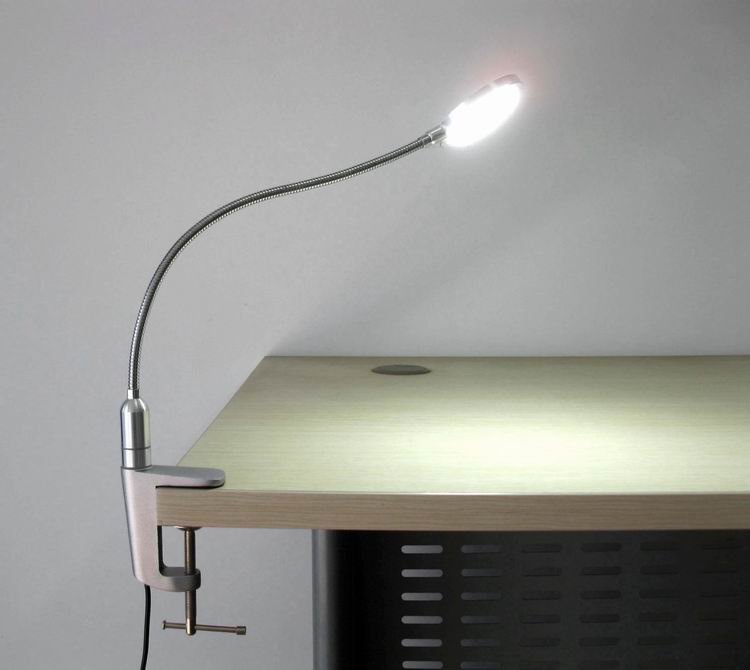... but an other step from unbaffled is to fully suspend the drivers. ... Believe me - there is a lot to gain in sound quality by suspending the drivers this way.
StigErik,
if I remember correctly, you made a jump from a rather large baffle (left) to baffleless and suspended drivers (right). No real small baffles as a step in between. Would you dare to roughly guess how much of the positive change was due to "no more baffle" and how much to the suspension?
Attachments
Your plots show a small off-axis bump between 1 and 2 khz.
I remember now. That was when I had the midrange still on the front of an 11" wide baffle:
The hole is left over from an XT1086 WG I used to have in there. I'm pretty sure the problem is with the baffle / magnet reflections / resonance, because when I measured the midrange 'bare', that issue went away:
When mounted to the front of a baffle, the 1-2kHz region is reversed - there's a dip in the front, and a bigger peak in the back.
I went with a small baffle around the midrange (and mounted the driver on the back) to hopefully smooth out diffraction effects from the driver edge, and to have something to mount the tweeter to. I haven't done proper polars on the 8" baffle yet, but on-axis, the 1.6kHz dip is gone, so I'm hopeful that it's OK.
Counting the number of curves in each plot I haven't been able to make sure which curve represents which angle. Would you please clarify?
It's all eyeballed, I don't have a turntable. I'd say, roughly 15 degrees to start with, then getting wider towards the end, and the last one is usually a big step up, and at around 75 degrees.
Saturday I'll probably be in the opportunity to compare the Neo3W to the Neo3PDR.
I was torn on that decision too, and mostly tossed a coin and went with the PDR. There are a couple of measurements on this forum of both drivers 'bare', but it would be good to get comparable measurements from the same setup, I don't think I've seen that anywhere. The sims in Edge predict what you said - better CD, but off-axis falling off faster for the non-PDR. I'll definitely be looking forward to your comparison.
Do you have any pictures of the back of your speakers? I'd like to see how you mounted everything, since my mechanical skills are really poor. For example, it looks like you mounted the Neo3 upside down, and I was wondering why I didn't think of that, that would simplify some of the mounting problems right there
Attachments
Bare Neo3 vs compression driver
So how do you like the Neo3 vs the compression driver that you took out?
.
The hole is left over from an XT1086 WG I used to have in there.
.
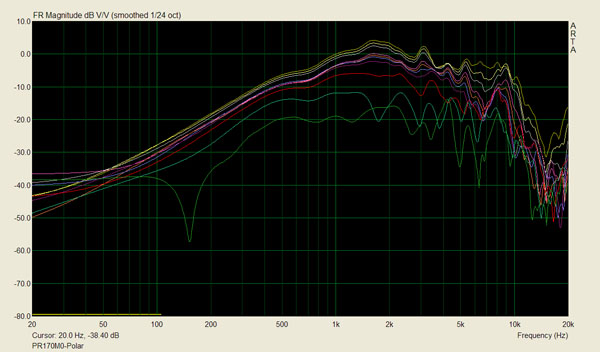
Well, a lot has changed. My progression over the last 2-3 years (same dark-brown baffle pictured above):
* BMS driver on XT1086 - Treble sounded pretty good, very clean and dynamic. The AC offset was more than my passive XO skills could handle. I got it kinda-sorta phase aligned with the midrange, but not really. There was always a disconnect between the treble and midrange that I couldn't fix
* Put a rectangular piece of plywood to cover the hole, cut a smaller hole in the plywood, used a B&C DE10 / ME10. Treble wasn't quite as good as the BMS / XT1086, but the WG is a lot shallower, so the phase matching was easier. Had to move the XO point up because the ME10 loses pattern control before the XT1086
* Same drivers, switched to a DCX. Now the AC offset was no longer a problem. Sound was the best so far, I could clearly hear the difference with having the tweeter properly phase matched with the midrange. But this still didn't solve one problem I had all along - the treble soundstage was disconnected from the rest of the music. Everything would be far behind the speakers, until a cymbal came along, and that was at the plane of the speakers. The DCX helped with this quite a bit, but didn't eliminate it.
* That's when I decided to try a dipole tweeter. I considered just adding a rear-firing ambiance tweeter (would probably have started with a cheap piezo as a test), but ultimately decided to go 'true dipole' with the Neo3. Not sure how much of a difference that makes, rear ambiance vs. true dipole in the tweeter region.
With the Neo3, the treble soundstage problem is definitely gone. I was expecting it to sound less dynamic than the CD tweeter, but I can't really say I hear a difference there. I've moved the XO down to 1800 Hz (used to be 2800Hz with the DE10), and I'm sure that plays a role too.
Everything put together, the treble has more texture to it now, and the finer details seem more balanced with the rest of the music, where you can hear them if you focus on them, or you can listen to the bigger picture. Hope that made some kind of sense, it's difficult to describe.
I have no idea how much of the change is due to CD vs. planar, WG vs. dipole, lower XO, better off-axis response on the midrange because it's on the back of a smaller baffle, and so on. I'm sure it all plays a role. Right now, these speakers are more enjoyable than any of my previous iterations, by a pretty big margin.
* BMS driver on XT1086 - Treble sounded pretty good, very clean and dynamic. The AC offset was more than my passive XO skills could handle. I got it kinda-sorta phase aligned with the midrange, but not really. There was always a disconnect between the treble and midrange that I couldn't fix
* Put a rectangular piece of plywood to cover the hole, cut a smaller hole in the plywood, used a B&C DE10 / ME10. Treble wasn't quite as good as the BMS / XT1086, but the WG is a lot shallower, so the phase matching was easier. Had to move the XO point up because the ME10 loses pattern control before the XT1086
* Same drivers, switched to a DCX. Now the AC offset was no longer a problem. Sound was the best so far, I could clearly hear the difference with having the tweeter properly phase matched with the midrange. But this still didn't solve one problem I had all along - the treble soundstage was disconnected from the rest of the music. Everything would be far behind the speakers, until a cymbal came along, and that was at the plane of the speakers. The DCX helped with this quite a bit, but didn't eliminate it.
* That's when I decided to try a dipole tweeter. I considered just adding a rear-firing ambiance tweeter (would probably have started with a cheap piezo as a test), but ultimately decided to go 'true dipole' with the Neo3. Not sure how much of a difference that makes, rear ambiance vs. true dipole in the tweeter region.
With the Neo3, the treble soundstage problem is definitely gone. I was expecting it to sound less dynamic than the CD tweeter, but I can't really say I hear a difference there. I've moved the XO down to 1800 Hz (used to be 2800Hz with the DE10), and I'm sure that plays a role too.
Everything put together, the treble has more texture to it now, and the finer details seem more balanced with the rest of the music, where you can hear them if you focus on them, or you can listen to the bigger picture. Hope that made some kind of sense, it's difficult to describe.
I have no idea how much of the change is due to CD vs. planar, WG vs. dipole, lower XO, better off-axis response on the midrange because it's on the back of a smaller baffle, and so on. I'm sure it all plays a role. Right now, these speakers are more enjoyable than any of my previous iterations, by a pretty big margin.
StigErik,
if I remember correctly, you made a jump from a rather large baffle (left) to baffleless and suspended drivers (right). No real small baffles as a step in between. Would you dare to roughly guess how much of the positive change was due to "no more baffle" and how much to the suspension?
Difficult to say for sure... but I'll try. I had three versions of the midrange baffle with the same size. That should account for the improvements gained with decoupling to some degree. The baffles were:
1) Regular MDF baffle as a a part of the woofer baffle
2) A new separate baffle, sand-filled for damping
3) The same as 2), but suspended from the woofer baffle (not a swing, but suspended with several layers of bubble-wrap
The difference between 1) and 2) was huge, no doubt. The difference between 2) and 3) was more subtle, but clearly audible. It was a greater freedom from "grain" and harshness. The sound got cleaner with what some call "darker background" in the soundstage.
Then I moved on to the fully suspended baffle-less thing with the same drivers. There was an improvement, although fairly small.
The greatest gains came from making a separate very dead/damped baffle, and from suspending the baffle.
I had the same experience with my giant twin 21" H-baffle subwoofers. When placed right on the floor they sound resonant and distorted. By just placing bicycle tire tubes under them, they "float" both physically and sonically! The difference is huge.
My conclusion might be that suspending the baffle and/or drivers is maybe the most important part, more important than having a baffle or not.
The baffle will of course affect off-axis response, and I did for sure get a lot better results with the small 5" drivers operated below dipole peak than the 8", regardless of baffles or not.
My own efforts are directed mainly at maintaining a dipole radiation pattern at higher frequencies in order to keep directivity constant. In my experience baffle vibrations, especially when using such a minimalistic baffle, are not much of an issue. Just like driver-radiation they are partially short-circuited between front and back. Suspending the drivers has the theoretical drawback that you loose some output (Newton's second law).
My previous dipole had a relatively large baffle (about 45 cm times 120 cm). It was made out of thin plywood. It could be felt to vibrate along with the music, but I never really heard it as such. I deadened it anyway, covering it with a thick layer of lead and bitumen. The baffle became very dead and hardly vibrated anymore, but soundwise I was never sure it made a difference.
Decoupling the bass panel from the floor might make a difference, as coupling it to the floor might lead to kinetic energy transferring to the floor.
My previous dipole had a relatively large baffle (about 45 cm times 120 cm). It was made out of thin plywood. It could be felt to vibrate along with the music, but I never really heard it as such. I deadened it anyway, covering it with a thick layer of lead and bitumen. The baffle became very dead and hardly vibrated anymore, but soundwise I was never sure it made a difference.
Decoupling the bass panel from the floor might make a difference, as coupling it to the floor might lead to kinetic energy transferring to the floor.
Interesting Neo3
Very interesting that the naked Neo3 can play in the same leagues, and surpass, a more expensive compression/ waveguide.Well, a lot has changed. My progression over the last 2-3 years (same dark-brown baffle pictured above):
* BMS driver on XT1086 - Treble sounded pretty good, very clean and dynamic.
With the Neo3, the treble soundstage problem is definitely gone. I was expecting it to sound less dynamic than the CD tweeter, but I can't really say I hear a difference there.
Everything put together, the treble has more texture to it now, and the finer details seem more balanced with the rest of the music,
I have no idea how much of the change is due to CD vs. planar, WG vs. dipole, lower XO, better off-axis response on the midrange because it's on the back of a smaller baffle, and so on. I'm sure it all plays a role. Right now, these speakers are more enjoyable than any of my previous iterations, by a pretty big margin.
It just occurred to me that by running the Neo bare as dipoles, notch filter is required for the dipole peak. This lead to even lower harmonic distortion right?
If the peak is designed to occur at around 1-2 khz then the tweeters can be crossed low comfortably due to the notch filter. This may require a small baffle.
The tradeoff is perhaps the smooth region would not be as high as 6khz as shown.
If the peak is designed to occur at around 1-2 khz then the tweeters can be crossed low comfortably due to the notch filter. This may require a small baffle.
The tradeoff is perhaps the smooth region would not be as high as 6khz as shown.
FWIW, I tried putting the wrong kind of foam around the Neo3 (it was a closed cell foam, basically weatherstripping). So it effectively worked as a wider baffle, I think. The on-axis response improved a bit, and the off-axis got worse.


I plan to play around some more with foam, maybe felt, maybe cut slits into round PVC pipes and put them on the edges. Right now, I don't think I can really hear that 7kHz null, so I'm unsure if fixing that by sacrificing the off-axis response is worth it.
Here are some measurements from tonight. Gated polars, front and back. Green is ARTA's power average. Angles are approximately 15 degrees.

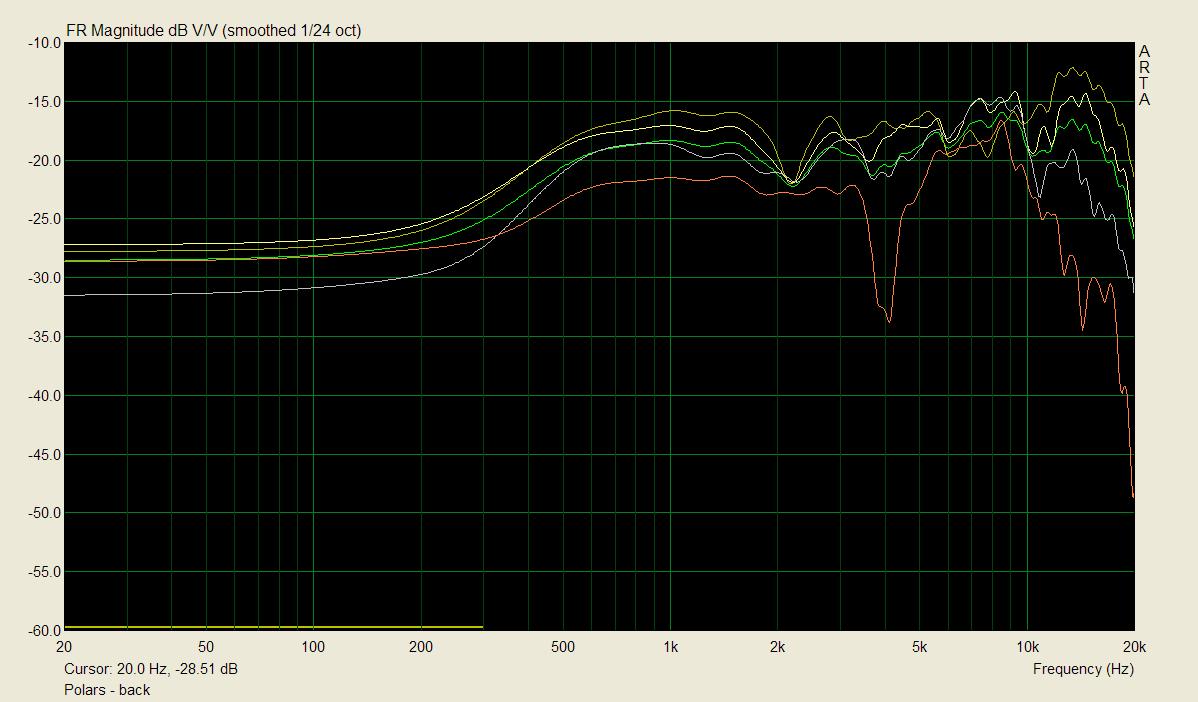
The back is going through that spine, and the tweeter has a .09ms delay to align it on the front, which of course makes it worse on the back (I suspect that's where the 2kHz notch comes from, since that's right around the XO frequency).
I plan to play around some more with foam, maybe felt, maybe cut slits into round PVC pipes and put them on the edges. Right now, I don't think I can really hear that 7kHz null, so I'm unsure if fixing that by sacrificing the off-axis response is worth it.
Here are some measurements from tonight. Gated polars, front and back. Green is ARTA's power average. Angles are approximately 15 degrees.
The back is going through that spine, and the tweeter has a .09ms delay to align it on the front, which of course makes it worse on the back (I suspect that's where the 2kHz notch comes from, since that's right around the XO frequency).
Attachments
Thanks for your detailed explanation. Makes me believe that I should go for very small baffles - just to ease mounting - for midranger and tweeters first. And simultanously providing for some additional string suspension if things work out fine.My conclusion might be that suspending the baffle and/or drivers is maybe the most important part, more important than having a baffle or not.
Yes, that's the right cable. Buy a long one, so you can adjust EQ from your prefered listening position.
Hi Stig Erik,
I've bought and connected the cable, but I can't get the system to work. I've downloaded the software from the Behringer website, but when I try to connect, it says COM port in loop mode. I have no idea what this all means. Do you? Any help would be much appreciated.
Sadly I haven't been able to connect the DCX to my laptop. Too bad, but I managed to further optimize the response manually.
This morning I went outside to do some measurements. It took me an hour to set up the entire system in the garden and another 4 hours to measure and adjust it. My ears and fingers nearly froze off, but the response looked superb! After having finished everything it took me another hour to set up the entire system in my room again. I warmed myself with a large cup of coffee at the fireplace. Then I went to the living room and listened to the system I had just so painstakingly optimized and I realized it sounded less good than it had earlier this morning! I ran some measurements and they looked absolutely worthless! Lesson learned: don't measure your system outside when it's -6 degrees Celsius!
This afternoon I made some more adjustments, comfortably warm in the house this time, and i'm now listening to the following:
The green curve is the power average. The other curves are, top-down 0 degrees up to 90 degrees off-axis.
This morning I went outside to do some measurements. It took me an hour to set up the entire system in the garden and another 4 hours to measure and adjust it. My ears and fingers nearly froze off, but the response looked superb! After having finished everything it took me another hour to set up the entire system in my room again. I warmed myself with a large cup of coffee at the fireplace. Then I went to the living room and listened to the system I had just so painstakingly optimized and I realized it sounded less good than it had earlier this morning! I ran some measurements and they looked absolutely worthless! Lesson learned: don't measure your system outside when it's -6 degrees Celsius!
This afternoon I made some more adjustments, comfortably warm in the house this time, and i'm now listening to the following:
An externally hosted image should be here but it was not working when we last tested it.
The green curve is the power average. The other curves are, top-down 0 degrees up to 90 degrees off-axis.
Do you have any pictures of the back of your speakers? I'd like to see how you mounted everything, since my mechanical skills are really poor. For example, it looks like you mounted the Neo3 upside down, and I was wondering why I didn't think of that, that would simplify some of the mounting problems right there
I missed this somehow. Yes, I mounted the Neo3 upside-down.
An externally hosted image should be here but it was not working when we last tested it.
For all you subjectivists: note the 22 uF electrolytic in series with the tweeter.
That looks really good! Did you put in any EQ to handle the 6-8kHz region?
The problem there was not only diffraction. A lot of it appeared to be resonances. Equalizing them led the results shown.
This afternoon I made some more adjustments, comfortably warm in the house this time, and i'm now listening to the following:
An externally hosted image should be here but it was not working when we last tested it.
The green curve is the power average. The other curves are, top-down 0 degrees up to 90 degrees off-axis.
Amazing!
Is this the PDR or normal?
And did you need to boost the lower freq (using shelving lowpass)?
- Status
- This old topic is closed. If you want to reopen this topic, contact a moderator using the "Report Post" button.
- Home
- Loudspeakers
- Multi-Way
- Unbaffled Dipole
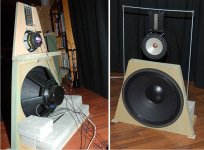
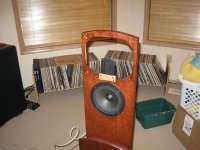
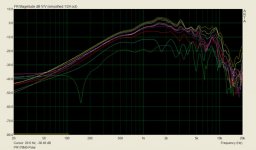
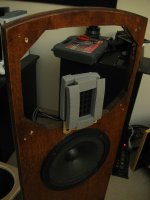
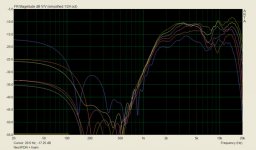
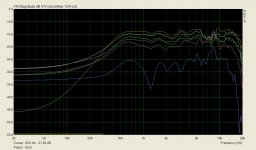
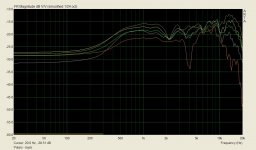
 .
. 